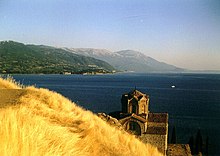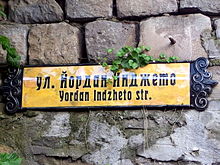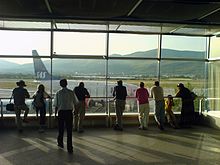The Balkan Peninsula in southeastern Europe is located between the Adriatic Sea and the Black Sea. The region has a mixed scenery with many tall mountain ranges, as well as deep forests, plains and rivers.
Countries

| Albania A beautiful and diverse country with impressive castles, long coastlines and a unique culture and history. |
| Bosnia and Herzegovina A political hotbed, but also an impressive mix of cultures with beautiful historic cities. |
| Bulgaria A melting pot of East and West, with beautiful beaches. |
| Croatia Croatia has renowned natural beauty, long coastlines, party islands, lots of sun hours and its Venetian history make it one of the Mediterranean's top travel destinations. |
| Kosovo One of the more adventurous places in the region; the traveller looking for something different won't be disappointed. |
| Macedonia Known for its traditional villages and churches, Macedonia also has some of the best wildlife. |
| Moldova A pastoral and multi-ethnic country, only considered Balkan due to its cultural ties with Romania. |
| Montenegro The Bay of Kotor, the Budva Riviera, winter sports and natural scenery, Montenegro is one of the most traveller-friendly countries in the region. |
| Romania While it's not entirely Balkan (the region of Transylvania lies in Central Europe), Romania offers a wonderful combination of old and new, mixing dance halls with Dracula. |
| Serbia Historic cities, monasteries, national parks and a good nightlife, Serbia has a lot to offer the traveller. |
| Transnistria This unrecognized, de facto republic claims eastern Moldova; visiting it comes closest to what life in a communist state in the Cold War must have been like. |
Some strictly geographical definitions define the Balkan peninsula as the lands south of the rivers Sava and Danube from the city of Belgrade. This however is not an expedient division when considering countries. Slovenia is sometimes considered to be part of the Balkans, but it is increasingly considered part of Central Europe. Greece occupies the tip of the Balkan Peninsula; however, most of Greece's major travel destinations (apart from Athens) lie upon its islands, which – along with its general culture – make it more aptly aloof from the Balkans.
Cities

- 1 Belgrade – known as the White City, the capital of Serbia
- 2 Bucharest – nicknamed the Little Paris, the 10th largest city in the EU
- 3 Chişinău – a modern city with over half a million inhabitants
- 4 Podgorica – the locals ski in winter, and head for the beaches in summer
- 5 Sarajevo – the heart of the Balkans and the trigger for World War One
- 6 Skopje – near the Matka Canyon in the Republic of Macedonia
- 7 Sofia – Bulgaria's lively capital in the mountains
- 8 Tirana – Albania's economic hub and a former Ottoman city, renowned for the beauty outside the city's limits
- 9 Zagreb – the capital of Croatia gets plenty of visitors each year
Other destinations

- 1 Brașov – an old city in Romania with many fortresses around it
- 2 Dubrovnik – the Pearl of the Adriatic
- 3 Makarska – the ancient gateway into the endless ocean, in southern Croatia
- 4 Ohrid – many old churches and the Tsar Samoil's fortress
- 5 Plitvice Lakes – a large Croatian national park with plenty of waterfalls
- 6 Prilep – you will be amazed by the beauty and the things that this beautiful city offers
- 7 Sibiu – 2007 European Capital of Culture, surrounded by hundreds of fortified churches
- 8 Zlatibor – a mountain resort in the heart of Serbia
- 9 Plovdiv – 2019 European Capital of Culture, mixing the roman ancient ruins with old traditional bulgarian renaissance houses
- 10 Veliko Tarnovo - The old capital of the Second Bulgarian Empire
- 11 Nesebar - ancient town is full of medieval churches, is a UNESCO World Heritage site.
- 12 Curtea de Argeș - old Wallachian fortress.
Understand
The Balkans contain charming multicultural towns, impressive monasteries and citadels dotting the hillsides, mighty mountains sprinkled with a liberal dose of beautiful forests and pleasant lakes, and last but not the least a great folk music tradition—coming off both as much joyful and melancholic as it could be—all survived various wars, if sometimes suffered a bit from the atrocities. With hundreds of kilometres of coastline on both the Adriatic and Black Seas, beachgoers won't be disappointed in this region, either.
The Balkans have been the borderland of many great powers; the Roman Empire (surviving as the Byzantine Empire until the 15th century), the Ottoman Empire, the Austro-Hungarian Empire, and the influence sphere of the Soviet Union. From the end of World War I the Western Balkans were unified in Yugoslavia, until the country fell apart in the 1990s, with a series of wars between the new states. In the 2000s, the Balkan nations have either joined the European Union, or applied for membership.
Talk

In this patchwork of countries and peoples, language learning is as complicated as one wishes to make it. At the simplest level, there are four main languages: Albanian, Bulgarian, Romanian and Serbo-Croatian. A bit of Russian also goes a long way, especially in Moldova and Transnistria.
Looking deeper you have:
- Bulgarian, spoken in Bulgaria, very closely related to Macedonian;
- Macedonian, the main language of Macedonia;
Nationalists and linguists will assert that a unified Serbo-Croatian language does not exist. However, the traveller with even a fairly strong grasp of things linguistic will find them one and the same. The distinct branches of Serbo-Croatian are:
- Bosnian, which is spoken in Bosnia and Herzegovina;
- Croatian, which is spoken in Croatia and Bosnia and Herzegovina;
- Montenegrin, which is spoken mainly in Montenegro;
- Serbian, which is spoken mainly in Serbia, Bosnia and Herzegovina, Montenegro and portions of Kosovo. Serbian can be written in either Cyrillic or Latin letters.
Together with Slovene, Bulgarian and Macedonian, the Serbo-Croatian languages are members of the closely knit South Slavic language group.
Some other useful languages might be Turkish, which many people in Greece and Bulgaria speak, and Romani may be useful in all of the Balkan states. Most of the people, especially in cities and touristic areas speak English, and sometimes German, Italian, French (in Romania).
German used to be common in the area during the heyday of the Austro Hungarian Empire and some time afterwards but has been largely supplanted by English as a lingua franca. However, areas frequently visited by German and Austrian tourists still have people speaking German. Russian was a compulsory second language during the communist era and may be spoken by some older people, but has declined in importance since the collapse of the iron curtain, and with the exception of Moldova has largely been supplanted by English as the foreign language of choice.
Get in

By plane
There are numerous international airports in the Balkans. The major airports in the region are (by country):
- Albania: Tirana
- Bosnia and Herzegovina: Sarajevo
- Bulgaria: Sofia,Plovdiv,Varna, Bourgas
- Croatia: Zagreb, Split, Rijeka, Zadar, Dubrovnik
- Kosovo: Priština
- Macedonia: Skopje, Ohrid
- Moldova: Chişinău
- Romania: Bucharest, Timisoara
- Serbia: Belgrade, Nis, Vrsac
Only the capital city airports have many regular flights throughout the year. Croatia's coastal airports are well served by low-cost airlines during the summer, while in winter there are only a few flights to Zagreb and Germany. Ohrid is served primarily by seasonal flights, and Serbia's airports other than Belgrade and Niš have no commercial flights as of 2018, even though they have international status.
By boat
Get around
- See also: Driving in Europe
Though three of the Balkan countries (Croatia, Bulgaria and Romania) have joined the European Union with others on the way, no countries in Balkans have implemented the Schengen Treaty yet, which means, unlike most of the rest of Europe, border controls are still a reality in the region—which is rather inconvenient but a joy for the ones who want all those entry and exit stamps on their passports.
By train
Croatia and Romania have well developed rail networks and getting around by train is fairly convenient. Train travel in Bulgaria is a little more rough and ready. Elsewhere, the once decent networks have been neglected. While there are services and there are some stunning journeys to be had, train travel in the other countries cannot be done on a whim and requires a little forward planning but the effort is worth making.
Fares on trains within each country are very cheap. International fares are also very reasonably priced.
The Balkan Flexipass rail pass is valid in Bulgaria, Greece, Macedonia, Montenegro, Romania, Serbia and Turkey. However given the low price of normal tickets, it may represent false economy.
By bus
- See also: Intercity buses in Europe
The bus networks are extensive throughout the Balkans, and is often the fastest way to move around. More info at the Bus travel in the former Yugoslavia page.
See


Itineraries
Do
Events
- Acrobatics festival. Krupa na Vrbasu, BiH - 25 August - 2 September 2018. Circus skills in the canyon.
- EXIT Festival. Novi Sad, Serbia, 12–15 July 2018 - An annual rock festival held in early July, which many musicians and bands from all over Europe attend.
- Guča festival. Guča (Гуча) Serbia, - An annual trubački (trumpet) music festival held in the summer. This genre of music is best known as ethnic jazz, and is best played by the Balkan Roma people. 8–12 August 2018
- Ohrid Summer Festival, Ohrid, Macedonia - An international culture festival held annually from July through August.
Activities
Winter sports
- Bosnia and Herzegovina was the host for the 1984 Winter Olympics, and after the 1990s, the alpine facilities are well restored. Around Sarajevo and Travnik are Olympic-grade mountains.
- In Serbia, you can ski in Kopaonik and Zlatibor.
LGBT
Whereas it is generally not safe to openly display gay behaviour in the Balkans (See "stay safe" section below) there are many underground alternatives which are supportive of the LGBT community.
Eat
The Balkan cuisines have similarities with the Italian cuisine, the Russian cuisine, and the Middle Eastern cuisine.
Drink
Regional firewater of choice is rakija (spelling varies from country to country; and despite the similarity in the name it has little to do with Turkish raki), a hard liquor (around 40%, and can be higher if home-made) common to all countries in Balkans. Rakija is distilled out of just about any fruit grown in the region, with the most popular varieties being plum, apricot, mulberry, and grape.
Another local drink is boza, a thick and sweet ale made of millet, maze, or wheat with a very low (less than 1%) alcohol content and traditionally drunk in winters.
There are excellent local beers to be had in each country in the region. Wine is also common, the peninsula being dotted by vineyards from one end to another.
Low taxes on alcohol coupled with a laid-back lifestyle and a liberal attitude towards alcohol consumption mean even smaller towns in the region has a considerable nightlife scene. Belgrade in particular is noted as the region's party hotspot.
Stay safe

While the horror stories of the 1990s are long gone and the likelihood of an armed conflict in the foreseeable future is next to none, unexploded land mines as a legacy of Yugoslav Wars continue to be a safety risk, especially in Croatia, Bosnia and Herzegovina, Kosovo, and Serbia. What is worse about them is that they are where you don't expect them to be at all—they tend to be moved away from their original positions by the abundant rainfall in the region, and therefore riverbanks close to former hotbeds of conflict are especially dangerous. Don't stray too far into wilderness unless you are absolutely sure where you are heading is free of mines.
In many Balkan countries, it is not a good idea to openly display gay behavior.
The draft (promaja) is considered dangerous in the Balkans. Keep doors and windows closed except during hot weather.
Go next
The Balkan countries are surrounded by Greece and Turkey to south, Ukraine to northeast, Central Europe to northwest, and Italy to west across the Adriatic, all of which have greatly influenced the regional culture now and then.

